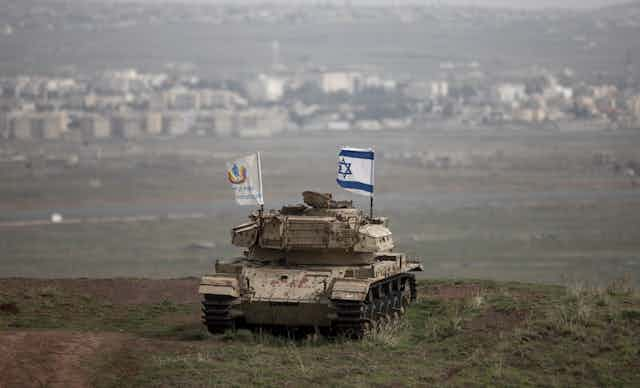When Iran recently attacked the Israeli-occupied Golan Heights from its positions in south-west Syria, Israel responded with a volley of air strikes that it says all but destroyed “almost all the Iranian infrastructure in Syria”. It was a dramatic flare-up in a long-running enmity – and it was no coincidence that it happened over one of the most contested areas in the Middle East.
When did Israel take full control of the Golan Heights, and why?
The Golan Heights is an area of 1,800km² on the border between Israel and Syria. Today it’s mostly occupied by Israel, but it was under Syrian sovereignty until June 1967, when Israel took control of most of the area in the Six-Day War, a military conflict with Egypt, Jordan and Syria. Although Israel controls only about two-thirds of what is known as the Golan Heights, it controls the most strategic points.
Israel captured the Golan Heights for several reasons, but two in particular stand out: to expand its borders, and to create a buffer zone against Syria.
There is still much debate and controversy about who started the Six-Day War. While Israel struck first in a surprise attack, Israeli governments since have always argued that the war was not an act of aggression but a pre-emptive military campaign meant to secure Israel in its early years of statehood.
What conflicts have revolved around the heights?
Ever since Israel took control of the Golan Heights in 1967 there have been sporadic border skirmishes and exchanges of fire. The only major interstate conflict that’s taken place since the Israeli occupation is the 1973 Arab-Israeli War, know to Arabs as the Ramadan War and to Israelis as the Yom Kippur War.
During this conflict, Israel was confronted by two Arab fronts: Egypt on the Sinai peninsula and Syria in the Golan Heights, armed with up-to-date weapons from the Soviet Union. A very tough and bloody battle took place in the Golan Heights between the Syrian and Israeli forces.
Had it not received immediate American military aid, Israel could have lost not just the Golan Heights but the entire military campaign. Instead, Israel still occupied the Golan Heights and officially annexed it in 1981. Sporadic border skirmishes occur till this very day.
Is Israel’s occupation of the area legal?
In a nutshell, Israel’s occupation of the Golan Heights is illegal under international law. To understand why, it’s very important to remember three crucial resolutions passed by the UN Security Council: UNSCR 242 (1967), UNSCR 338 (1973) and UNSCR 497 (1981).
In its first clause, UNSCR 242 clearly calls for the “withdrawal of Israel armed forces” from territories occupied in the Six-Day War – meaning the Sinai Peninsula, West Bank and the Golan Heights. UNSCR 338, passed during the Yom Kippur/Ramadan War, calls on all parties involved to implement UNSCR 242 “in all its parts”.

But UNSCR 497 goes further, and explicitly highlights the illegality of the Israeli occupation: “The Israeli decision to impose its laws, jurisdiction and administration in the occupied Syrian Golan Heights is null and void and without international legal effect.”
Resolutions 242 and 338 in particular have informed peace initiatives ever since they were passed. Both were used to legitimise Arab demands in peace plans such as the 1982 Fez Plan and the 2002 Arab Peace Initiative, both of which Israel rejected.
Why is the area so important to Israel?
The Golan Heights’ high altitude provides it with observation points deep into Syria, with which Israel has never formally made peace. Israel has long wanted to reach bilateral political settlements with some of its Arab neighbours, and one of its strategies was to occupy territory and return it through negotiation. In the vernacular of Arab-Israeli relations, this is known as “land for peace”.
Israel hopes it can use areas such as the Golan Heights to initiate a negotiation process that implicitly legitimises it as a state. This is something Arab leaders have struggled to deal with; any potential concession to Israel’s claim to statehood could undermine their own legitimacy and popularity with their own populations. Remember that in years gone by, President Anwar Sadat of Egypt and King Abdullah I of Jordan were both assassinated because of their dealings with Israel.
What’s behind Iran’s interest in the area?
Iran’s investment in the Golan Heights is more symbolic than material. The Israeli occupation provides fodder for the Iranian government’s furious anti-Israeli rhetoric, which is meant to generate and reinforce wider support across the Middle East. But boasting about fighting Israel is far more important than actually fighting Israel.
In reality, Iran wants to avoid a direct military confrontation with Israel over the Golan Heights, as it knows Israel comfortably outweighs it on technical military might. That’s why Iran prefers to exploit forces as Hezbollah in the south of Lebanon and Bashar al-Assad’s military in Syria as proxies between them and Israel. This enables Iran to say it’s confronting Israel without taking on the risks of an actual confrontation.

